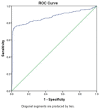Shear wave elastography in the evaluation of renal parenchymal stiffness in patients with chronic kidney disease
- PMID: 29869920
- PMCID: PMC6223162
- DOI: 10.1259/bjr.20180235
Shear wave elastography in the evaluation of renal parenchymal stiffness in patients with chronic kidney disease
Abstract
Objective: To investigate the use of shear wave elastography (SWE)-derived estimates of Young's modulus (YM) as an indicator to detect abnormal renal tissue diagnosed by estimated glomerular filtration rate (eGFR).
Methods: The study comprised 106 chronic kidney disease (CKD) patients and 203 control subjects. Conventional ultrasound was performed to measure the kidney length and cortical thickness. SWE imaging was performed to measure renal parenchymal stiffness. Diagnostic performance of SWE and conventional ultrasound were correlated with serum creatinine, urea levels and eGFR.
Results: Pearson's correlation coefficient revealed a negative correlation between YM measurements and eGFR (r = -0.576, p < 0.0001). Positive correlations between YM measurements and age (r = 0.321, p < 0.05), serum creatinine (r = 0.375, p < 0.0001) and urea (r = 0.287, p < 0.0001) were also observed. The area under the receiver operating characteristic curve for SWE (0.87) was superior to conventional ultrasound alone (0.35-0.37). The cut-off value of less or equal to 4.31 kPa suggested a non-diseased kidney (80.3% sensitivity, 79.5% specificity).
Conclusion: SWE was superior to renal length and cortical thickness in detecting CKD. A value of 4.31 kPa or less showed good accuracy in determining whether a kidney was diseased or not. Advances in knowledge: On SWE, CKD patients show greater renal parenchymal stiffness than non-CKD patients. Determining a cut-off value between normal and diseased renal parenchyma may help in early non-invasive detection and management of CKD.
Figures


References
-
- Goh BL, Ong LM, Lim YN. 22nd report of the Malaysian dialysis and transplant registry 2015. The National Renal Registry. 2015. Available from: https://www.msn.org.my/msn/Doc/PublicDoc_PB/Publication/mdtr22nd/content....
MeSH terms
LinkOut - more resources
Full Text Sources
Other Literature Sources
Medical
Research Materials
Miscellaneous

